“We Do”: Mass Weddings in Singapore
Initially inspired by the “New Life Movement” in China, couples in Singapore would opt for mass weddings to save money.
By Seow Peck Ngiam and Benita Lim
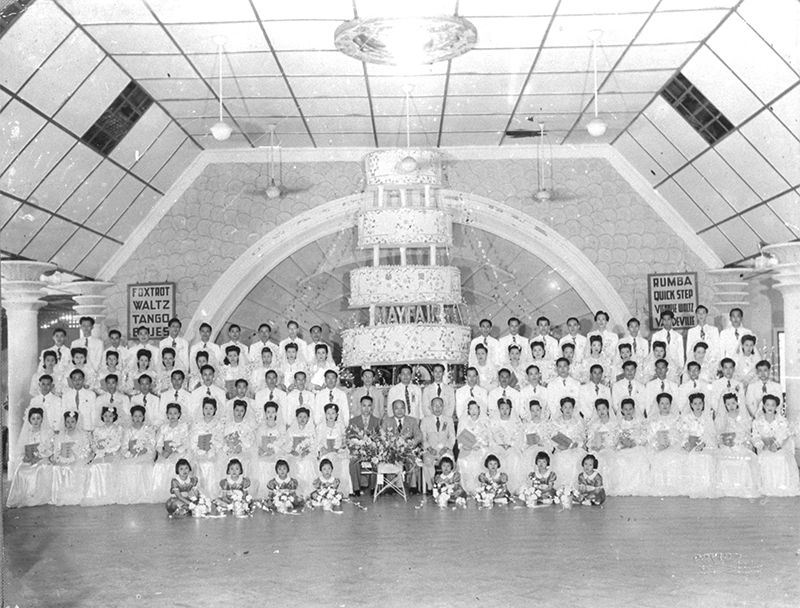
For most couples, their wedding is a special moment, a major milestone shared with friends and family, but with the couple firmly in the spotlight. However, in the late 1930s, some couples in Singapore did things a little differently: they began opting for mass wedding ceremonies, where multiple couples got married at the same time.
The appeal? Cost. “Old-fashioned Chinese weddings which cost from $1,000 up have no appeal for the modern Malayan Chinese,” the Straits Times reported. “Thrifty grooms prefer to spend the money on their new homes, while brides prefer white satin, orange blossoms and a veil to elaborate dress and the heavy gold jewellery of tradition.”1
The Novelty of Mass Weddings
Mass weddings in Singapore were inspired by the “New Life Movement” in China which advocated for simpler and more frugal lifestyles. This movement, which involved mass weddings in Shanghai, resonated with the Chinese community in Singapore who sought more affordable alternatives to traditional extravagant weddings.
“There has been much discussion among local Chinese about following the example of Shanghai by adopting the system of mass marriages, the advantages of which, some believe, are that it may do away with expensive Chinese customs connected with marriages; it saves parents from the burden of having to provide dowries for marriageable daughters; and it will eventually bring about a uniformity of marriage customs among the local Chinese including the local-born community,” noted the Straits Times.2
A wedding involving 10 couples at the Great World Cabaret on 1 February 1937 is believed to be the first mass wedding in Singapore. It was sponsored by Great World, where each couple paid less than $40 for non-sponsored items such as the bridal attire. The ceremony was officiated by the Chinese Consul-General in Singapore, Kao Ling Pai. “Mass marriages are very wise in cases where the parties are not wealthy,” he said in Mandarin. “They are economical and convenient and it means young couples being able to begin their married life without making heavy expenditure.”3
The event, which drew over 2,000 spectators, began with brides in white satin cheongsams and headdresses and grooms in matching dark suits entering the hall during the “Wedding March”, then taking their seats with brides on one side and grooms on the other. After the Chinese National Anthem was played, the gathering bowed before the national and Kuomintang flags and the portrait of the late Sun Yat Sen.
Each couple then walked up in turn to Kao where they exchanged rings, bowed to each other and signed marriage certificates. The parents, or guardians, the “introducers” and Kao also put their signatures on the documents. Kao then presented each couple with their marriage certificate as well as booklets in Chinese and English titled “Outline of the New Life Movement”. After a photo session, the couples embarked on a celebratory city tour as newlyweds before proceeding to their homes.4
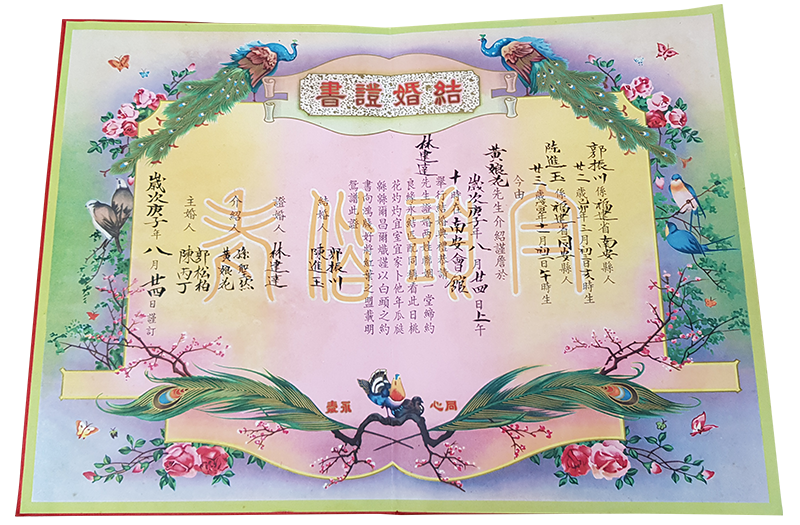
Building upon the success of the inaugural mass wedding, the Great World Cabaret hosted a second mass wedding ceremony on 19 December 1937 for another 10 couples, including one from Johor Bahru. It was quite similar to the first event except that this time around, the occasion also served as a fundraiser for the China Relief Fund which required each couple to pay $10.5
Mass Weddings Gain Traction
For non-Christian Chinese couples in the late 1930s, mass weddings offered one of the most cost-effective marriage options available. Alternative locations like the Chinese Consulate, clan associations and schools charged around $15 just for the venue. While registration at the Singapore Marriage Registry ($5) or having a church wedding ($10) were cheaper options, these were restricted to Christian couples.6
Following the principles of the “New Life Movement”, the Chinese Consulate began sponsoring and organising monthly mass weddings from 1939 onwards.7 Besides cost-effectiveness, participating in these mass weddings was a way for non-Christian couples to legitimise their marriage, which often involved prominent leaders in the Chinese community officiating the union.8
Ang Keong Lan, then 19, and his wife, Aw Ah Kim,9 were one of 32 couples who participated in a mass wedding organised by and held at the Chinese Consulate on 1 October 1939; it was witnessed by Consul-General Kao Ling Pai. “There were two marriage certificates – one for the bridegroom’s family and the other for the bride’s,” recalled Ang, who later became an entrepreneur and philanthropist. “All the marriage certificates were signed by the Consul as witness and by the respective guardians of the married couples as persons approving the marriage.”10 On top of the mass wedding, Ang’s family still hosted a traditional wedding feast for relatives and friends.11
Efforts to establish mass weddings as a sustainable social practice in Singapore were disrupted by the Japanese Occupation. Although the Malai branch of the Nanpo Kaihatsu Kinko (Southern Development Bank) and the Savings Encouragement Department attempted to organise a mass wedding for Malay couples at the Sultan Mosque in February 1944, this initiative failed to materialise.12
After the war, the Singapore Mayfair Musical and Dramatic Association revived the practice of mass weddings. The association organised the first postwar wedding ceremony on 12 January 1947. Officiated by the Chinese Consul, the ceremony was followed by a celebratory car procession through the city streets.13
Between 1948 and 1950, at least 12 mass weddings were held, attracting couples from across Malaya. The fifth ceremony on 16 May 1948 saw a record-breaking 42 couples, where each couple paid $30. Lim Boon Keng, a prominent member of the Chinese community, officiated at the signing ceremony. He congratulated the couples and advised them to view marriage as “sacred”.14
After the association was dissolved in 1950, the Chinese Young Men’s Christian Association took over the responsibility of organising mass weddings. Couples, however, needed to register separately with the Registrar of Marriages to legalise their marriage as this was not part of the mass wedding ceremony.15
Unlike previous mass weddings which were sometimes fully sponsored, couples now had to contribute a nominal fee of $30 which covered a range of expenses, including decorations and a tea reception for the couple and their parents.16
From 1952, Chinese clan associations got into the act as well. The Khek Community Guild held a mass wedding on 28 December 1952. It also sought to attract members from other Chinese dialect groups by offering their facilities to non-Khek couples.17 Eventually, this initiative inspired other Chinese clans such as Chin Kang Huay Kuan and Singapore Hokkien Huay Kuan to offer themselves up as venues.18
The Singapore Hokkien Huay Kuan conducted 17 mass wedding ceremonies between 1956 and 1960. These ceremonies attracted couples from all walks of life, including hawkers, clerks, tailors and shop assistants, as well as couples from other dialect groups.19 A mass wedding on 2 February 1958 drew international attention, with a camera crew from the United States flying to Singapore to capture footage of the event at the Hokkien Huay Kuan for an American television documentary.20
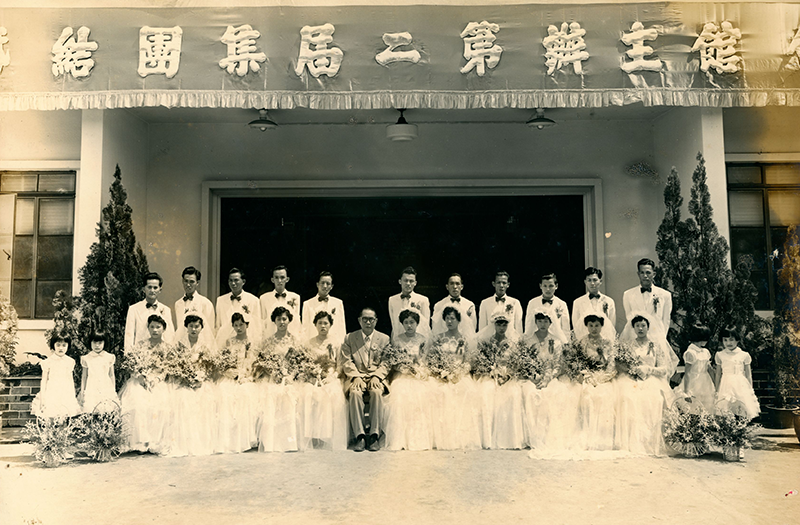
No to Mass Weddings
Not everyone was enamoured with the idea of a mass wedding though. In particular, the English-speaking Chinese were not keen on the concept, according to the Singapore Free Press. Bachelor Goh Seng Lim was adamant about not getting married in a mass wedding. “Pride keeps most of us away from mass weddings. Only a small percentage of the Chinese would like to go through this form of marriage,” he said. Neoh Teik Hong was similarly against mass weddings. “Those who can afford single marriages will definitely prefer it,” he noted.21
The concept also faced significant resistance in other communities. In a letter to the Straits Times published on 10 July 1948, Endra Rassip wrote that the idea of mass marriages for Muslims in Malaya as a way to reduce expenses was “impracticable” as it was “not only against the precepts of Islam but also against Muslim custom”. She suggested holding the wedding on only one day instead of over several days, and that only close friends and relatives be invited.22
In a debate organised by the Young Men’s Muslim Association on 19 August 1949, 15 participants disapproved of mass weddings while only three voiced support. Those in favour said that “mass weddings were economical, and would eliminate ‘bad customs’ associated with Muslim marriages”. The rest who disagreed were concerned with the un-Islamic practices.23
Media, Modernity and Mass Appeal
The first televised mass wedding for 50 couples in Singapore took place on 31 May 1969 and attracted over 300 applications from people of diverse backgrounds, including Tamil couples and a Malay couple. This affair was fully sponsored by Radio and Television Singapore and covered all expenses, including a reception for guests, and entertainment. (It did not cover wedding attire though.)
For many couples, participating in this televised mass wedding was a novel and exciting experience. “It was curiosity that made us do it,” said 25-year-old teacher Lim Kok Meng. “Years after, we will be able to think back to the time when we were part of this unusual event.” For Raymond Chan, also 25, the opportunity to appear on television was the main draw. Another participant, Nancy Chen, 35, said that she would not be as nervous with other brides present. “I decided to join in because with so many other couples I would be less conspicuous.” As an added incentive, the Asia Commercial Banking Corporation presented each couple with a $20 banking account.24
The telecast created a major business opportunity and commercial entities, particularly travel agencies and airlines, quickly capitalised on mass weddings by offering wedding-honeymoon bundles throughout the 1970s and 1980s. One notable example occurred on 30 September 1973 when a mass wedding for 150 Singaporean couples was jointly organised and sponsored by the People’s Scholarship Fund Projects Committee, C&E Tours Pte Ltd, Singapore Airlines, Asia Commercial Banking Corporation and Nanyang Siang Pau.25
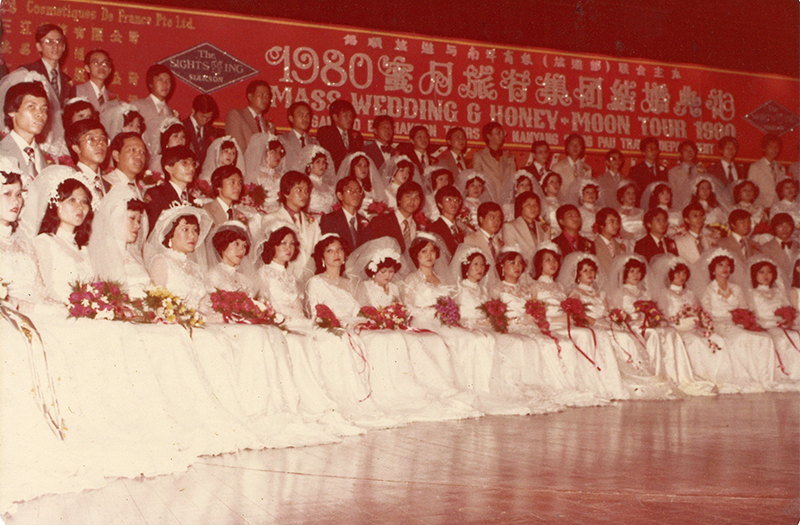
Beyond the ceremonial occasion, the event also raised funds for the government-established People’s Scholarship Fund, which supported tertiary education for promising Singaporeans. Another unique feature of the event was the simultaneous ceremonies in Malaysia and Hong Kong, each involving 60 couples.26
After the mass wedding, participants embarked on what the media dubbed a “jumbo” honeymoon – a reference to both the scale of the event and the thrill of flying on a jumbo jet as part of the experience. Destinations included Kuala Lumpur, Penang, Genting and Hong Kong.27
Such wedding-honeymoon packages became increasingly popular across the region in subsequent years.28 They were no longer seen merely as economical alternatives but were embraced for their convenience, novelty and shared celebration. Travel agencies expanded their offerings, providing comprehensive arrangements that covered not only logistics and ceremonies, but also coordinated entertainment, media coverage and travel itineraries that extended beyond Southeast Asia.29
Even as late as the 1980s, couples were still choosing to get married at mass wedding ceremonies. On 18 May 1980, Tan Li Kheng, now 71, and her husband Lee Chun Ho were married at the Neptune Theatre Restaurant in Mandarin Hotel at one such wedding. The event was organised by Siakson Tours and the Nanyang Siang Pau Travel Department and involved more than 80 couples. “Mass weddings were fashionable in those days,” she recalled. “I paid $2,800 that included the wedding ceremony, one table for guests for the lunch reception, and the 19-day honeymoon trip to Bangkok, Tokyo, Seoul, Taipei and Hong Kong. At each location, we had photo sessions and a dinner, and also received lots of souvenirs.” Tan found the entire experience memorable.30 The event was reported by Nanyang Siang Pau.31
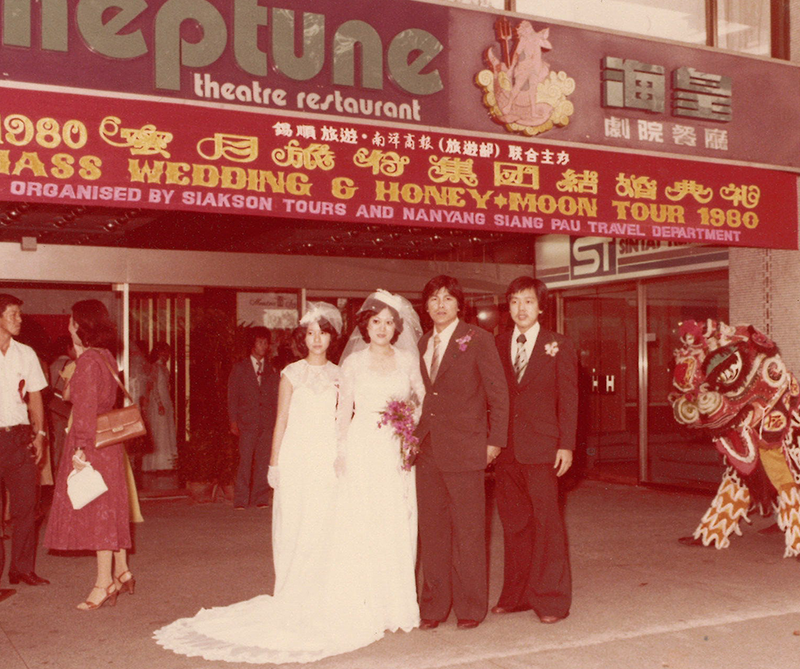
In the late 1980s, government agencies, including the Registry of Marriages (ROM) and the People’s Association, jumped on the bandwagon and organised several mass weddings in collaboration with private operators.
On 8 August 1988 (08/08/88), a date widely regarded as auspicious, ROM anticipated a spike in demand for marriage solemnisation and partnered with Oxley Travel Service to stage its first large-scale wedding ceremony at the Neptune Theatre Restaurant.32 A year later, on 24 September 1989, the People’s Association Social Development Section organised its debut mass wedding with Oxley at Shangri-La Hotel for 60 couples.33
Decline of Mass Weddings
Newspaper reports of mass weddings became noticeably fewer in the 1990s, likely reflecting a shift in public preference towards more personalised and intimate weddings. Computer analyst Cassandra Koh, 25, told the Straits Times that she would rather “do my own shopping and hunt around for the best bridal boutique, a florist who will deliver his goods, and decide for myself what design I want for my invitation cards”.34
Couples were still willing to walk down the aisle en masse if that meant they could do it on popular dates. On 20 September 2009 (20/09/2009), the Singapore Botanic Gardens hosted a mass wedding for 168 couples as part of its 150th anniversary celebrations. The following year, on 10 October 2010 (10/10/2010), the People’s Association, in collaboration with Lianhe Zaobao and Sentosa Leisure Group, organised a large-scale ceremony for 118 couples who exchanged vows on Sentosa.35
As wedding customs and practices continue to evolve alongside social values and cultural trends, the era of mass weddings remains a distinctive chapter in Singapore’s matrimonial landscape.
 Seow Peck Ngiam is a Senior Librarian with the National Library Singapore. Her responsibilities include the selection, evaluation and management of materials for the Chinese and donor collections. She also conducts research and writes for the library.
Seow Peck Ngiam is a Senior Librarian with the National Library Singapore. Her responsibilities include the selection, evaluation and management of materials for the Chinese and donor collections. She also conducts research and writes for the library.  Benita Lim is a Senior Manager at Resource Discovery and Management, National Library Board. She was formerly a Senior Librarian with the National Library, where she worked with the Singapore and Southeast Asia Collection, developing content as well as providing reference and research services.
Benita Lim is a Senior Manager at Resource Discovery and Management, National Library Board. She was formerly a Senior Librarian with the National Library, where she worked with the Singapore and Southeast Asia Collection, developing content as well as providing reference and research services. Notes
-
“$1,000 Weddings Now ‘Out of Fashion’,” Straits Times, 14 May 1949, 7. (From NewspaperSG) ↩
-
“Will Mass Marriages Come to Singapore?” Straits Times, 23 June 1935, 5. (From NewspaperSG) ↩
-
“Yesterday’s Mass Marriages,” Singapore Free Press, 1 February 1937, 9; “Mass Wedding in Singapore,” Malaya Tribune, 1 February 1937, 7. (From NewspaperSG) ↩
-
“Yesterday’s Mass Marriages”; “Mass Wedding in Singapore.” ↩
-
“Mass Wedding Fees Go to China Relief Fund,” Straits Budget, 23 December 1937, 11. (From NewspaperSG) ↩
-
“Uniform Wedding for All Non-Christian Chinese?” Straits Times, 13 March 1938, 5. (From NewspaperSG) ↩
-
“16 Couples Wed at Mass Wedding,” Morning Tribune, 5 June 1939, 2; “Mass Weddings,” Straits Times, 30 June 1939, 13; “16 Brides in Yesterday’s Mass Wedding,” Singapore Free Press and Mercantile Advertiser, 3 July 1939, 7; “Chinese Mass Wedding,” Malaya Tribune, 7 August 1939, 10. (From NewspaperSG) ↩
-
“Special Registries for Civil Marriages,” Straits Times, 19 February 1940, 10. (From NewspaperSG) ↩
-
“Obituary: Datin Aw Ah Kim,” Straits Times, 28 February 1998, 44. (From NewspaperSG) ↩
-
“Mass Wedding,” Straits Times, 1 October 1939, 10. (From NewspaperSG) ↩
-
Ang Keong Lan, oral history interview by Tan Ban Huat, 28 June 1980, transcript and MP3 audio, Reel/Disc 2 of 5, National Archives of Singapore (accession no. 000042), 14–16. ↩
-
“Mass Wedding Couples to Receive Special Gift,” Shonan Times (Syonan Shimbun), 29 January 1944, 1; “Mass Wedding Postponed,” Shonan Times (Syonan Shimbun), 16 February 1944, 1. (From NewspaperSG) ↩
-
“Weds 16 Couples Today, Will Himself Marry on Thursday,” Sunday Tribune (Singapore), 12 January 1947, 12. (From NewspaperSG) ↩
-
“84 Were Married – 2 Were Late,” Straits Times, 17 May 1948, 5. (From NewspaperSG) ↩
-
“Chinese Y to Revive Mass Marriages on Sept. 15,” Singapore Standard, 4 July 1951, 5. (From NewspaperSG) ↩
-
“They Plan $30 Weddings,” Straits Times, 14 August 1951, 7. (From NewspaperSG) ↩
-
“1st Mass Wedding at Khek Guild,” Singapore Standard, 29 December 1952, 3; “They Want More Mass Weddings,” Straits Times, 8 June 1954, 7. (From NewspaperSG) ↩
-
Han, S.Y., “jítuan hunli zhifeng yingzai xingqi” 集团婚礼之风应在兴起 [The trend of mass weddings should be revived], in 源Yuan no. 66 (April 2004): 17. (From National Library Singapore, call no. RSING 369.25957 Y) ↩
-
Guardian of the South Seas: Thian Hock Keng and Singapore Hokkien Huay Kuan (Singapore: Singapore Hokkien Huay Kuan, 2006), 106. (From National Library Singapore, call no. RSING 369.25957 GUA) ↩
-
“Mass Wedding for TV,” Straits Times, 3 February 1958, 2. (From NewspaperSG) ↩
-
Roger Yue, “Inquiring Camera Finds Out,” Singapore Free Press, 18 September 1953, 3. (From NewspaperSG) ↩
-
Endra Rassip, “Economy Without Mass Marriages,” Straits Times, 10 July 1948, 9. (From NewspaperSG) ↩
-
“Muslim ‘No’ to Mass Weddings,” Straits Times, 15 August 1949, 5. (From NewspaperSG) ↩
-
“The Mass Wedding of 50 Couples Will Be Seen Round the World,” Straits Times, 4 May 1969, 8; Shen Swee Yong, “Mass Weddings: Is It Really Cheaper by the Dozen?” Straits Times, 25 May 1969, 13. (From NewspaperSG) ↩
-
C&E Tours Pte Ltd., Ji tuan jie hun ji nian te kan 集团结婚纪念特刊 [Mass wedding souvenir magazine] (Singapore: C&E Tours Pte Ltd, 1973), unpaginated. (From PublicationSG) ↩
-
Ang Kok Peng, “The Mass Wedding Reception,” speech, Neptune Theatre Restaurant, 30 September 1973, transcript, Ministry of Culture. (From National Archives of Singapore, Document no. PressR19730930a); C&E Tours Pte Ltd., Ji tuan jie hun ji nian te kan, unpaginated. ↩
-
“Jumbo Honeymoon for 150 Couples,” New Nation, 12 September 1973, 2. (From NewspaperSG) ↩
-
Oxley Travel Service Pte Ltd., Hua yue jia qi mi yue lu xing 花月佳期蜜月旅行 [8th Grand Mass Wedding & Honeymoon Tours ’83] (Singapore: Oxley Travel Service Pte Ltd, 1983), 7. (From PublicationSG) ↩
-
Oxley Travel Service Pte Ltd., Hua yue jia qi mi yue lu xing 花月佳期蜜月旅行 [6th Grand Mass Wedding & Honeymoon Tours ’81] (Singapore: Oxley Travel Service Pte Ltd, 1981), unpaginated. (From PublicationSG); C&E Tours Pte Ltd., Ji tuan jie hun mi yue lu xing 集团结婚蜜月旅行 [6th Mass Wedding & Honeymoon Tour ’77] (Singapore: Oxley Travel Service Pte Ltd, 1977), unpaginated. (From PublicationSG) ↩
-
Tan Li Kheng, personal correspondence with Veronica Chee, 8 September 2025. ↩
-
“Nanyang shang bao xi shun luyou she lianhe zhuban jituan jiehun miyue luxing tekan” 南洋商報锡顺旅游社联合主办集團結婚蜜月旅行特刊 [Nanyang Siang Pau Travel Department co-organises the group’s wedding and honeymoon travel special] Nanyang Siang Pau 南洋商报, 18 May 1980, 17. (From NewspaperSG) ↩
-
“Registry Plans 8-8-88 Mass Wedding,” Straits Times, 1 May 1988, 1; Sharon Simon, “Places for 8-8-88 Registry Weddings All Snapped Up,” Straits Times, 11 May 1988, 1. (From NewspaperSG) ↩
-
“Where to Go for Honeymoon?” New Paper, 15 April 1989, 4; Tan Ee Sze, “SDS Love-Matches Tie the Knot at Mass Wedding,” Straits Times, 25 September 1989, 16. (From NewspaperSG) ↩
-
Christopher Khoo, “What Kind of Wedding Do You Want?” Straits Times, 25 July 1991, 2. (From NewspaperSG) ↩
-
Desmond Lim, “Saying ‘I Do’, 168 Times Over,” Straits Times, 21 September 2009, 1; Daryl Chin, “10/10/10,” Straits Times, 11 October 2010, 3. (From NewspaperSG) ↩

